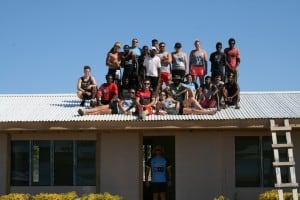
A villager joins the EIT team on the newly-constructed roof – from left, students Zac Wadley and Rayne Hungahunga , head of school Todd Rogers and carpentry tutor Campbell Johnston.
EIT students who helped rebuild cyclone-lashed medical centres in Vanuatu have returned to Hawke’s Bay with improved trades skills and a greater appreciation of the comforts of home.
Eight Māori and Pasifika students enrolled in electrical, carpentry and automotive programmes were hand-picked for the two-week trip. Accompanied by five staff, the students were part of a Manakura group, an EIT initiative supporting Māori and Pacific Island trades training achievement.
Re-roofing and re-cladding a health clinic in the remote village of Paunagnisu and upgrading a dispensary in Erakor, a 45-minute drive away, the party slept on mattresses under tarpaulins in a camping ground and cooked their own meals.
Rising at 5am, they worked until late morning, took a break during the hottest part of the day and then picked up tools to continue until dark.
As well as repairing the cyclone-damaged clinics, they also built a separate kitchen alongside the medical centre in Paunagnisu, upgrading a community facility that serves Vanuatu’s northern and outer islands.
Appreciative of their efforts, local villagers also helped with the work.
Head of EIT’s trades and technology school, Todd Rogers says the students came back to New Zealand with a greater understanding of how life is for national Vanuatuans, who, while owning few material possessions, are happy with their lot.
For most of the students, it was a first venture overseas.
“They had to get their own passports and they learnt a lot about their trades.”
As an example of that, Todd says the group made their own trusses – something that is no longer done on New Zealand construction sites.
The bigger of the two projects, the rebuilt Paunangisu health centre is now capable of standing up to the extremes of tropical weather. Striking the island nation in March, Cyclone Pam damaged the building so badly it could no longer function as a health centre.
“With a new roof and wall cladding, the only way the building is going to succumb to any further cyclones is if the concrete pad is ripped out of the ground.”
The trip attracted major sponsorship from The Skills Organisation and the Certified Builders Association as well as MITO and BCITO (the training organisations for the motor and building and construction industries), ITM and the EIT Students Association.
Todd says it can be difficult for contractors to get to outlying islands in the archipelago and the country’s Ministry of Health appreciated that the group had managed to complete the two projects within a fortnight.
“We’ve already been invited back for another three jobs,” he says, “all medical centres.”
The five EIT staff involved in the exercise intend to pay their own way for a return trip to Vanuatu in January.
